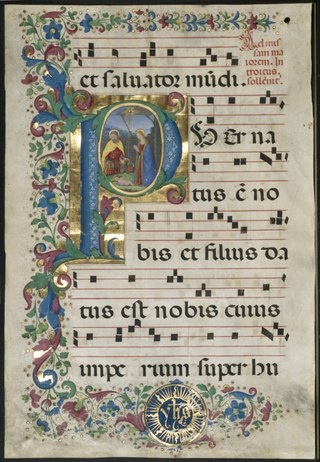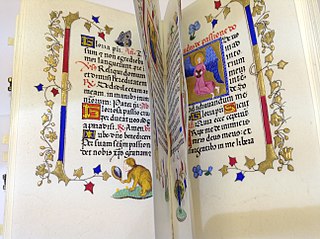
Calligraphy is a visual art related to writing. It is the design and execution of lettering with a pen, ink brush, or other writing instrument. Contemporary calligraphic practice can be defined as "the art of giving form to signs in an expressive, harmonious, and skillful manner".
Zhu Da (朱耷), also known by his pen name Bada Shanren (八大山人), was a late-Ming and early-Qing dynasty Chinese painter, calligrapher, and poet. He was born in Nanchang, Jiangxi, in 1626, at during the Ming-Qing Transition. Zhu was mentally ill and displayed erratic behavior. He was related to the House of Zhu, which got destroyed and executed by the new Qing dynasty. Fearing that he would also be purged and executed, he fled to a Buddhist temple and learned the teachings of Chan (Zen) Buddhism, becoming a monk for 30 years.

The National Gallery Prague, formerly the National Gallery in Prague, is a state-owned art gallery in Prague, which manages the largest collection of art in the Czech Republic and presents masterpieces of Czech and international fine art in permanent and temporary exhibitions. The collections of the gallery are not housed in a single building, but are presented in a number of historic structures within the city of Prague, as well as other places. The largest of the gallery sites is the Trade Fair Palace, which houses the National Gallery's collection of modern art. Other important exhibition spaces are located in the Convent of St Agnes of Bohemia, the Kinský Palace, the Salm Palace, the Schwarzenberg Palace, the Sternberg Palace, and the Wallenstein Riding School. Founded in 1796, it is one of the world's oldest public art galleries and one of the largest museums in Central Europe.

Mi Fu was a Chinese painter, poet and calligrapher who was born in Taiyuan during the Song dynasty. He became known for his style of painting misty landscapes. This style would be deemed the "Mi Fu" style and involved the use of large wet dots of ink applied with a flat brush. His poetry was influenced by Li Bai and his calligraphy by Wang Xizhi.

Asemic writing is a wordless open semantic form of writing. The word asemic means "having no specific semantic content", or "without the smallest unit of meaning". With the non-specificity of asemic writing there comes a vacuum of meaning, which is left for the reader to fill in and interpret. All of this is similar to the way one would deduce meaning from an abstract work of art. Where asemic writing distinguishes itself among traditions of abstract art is in the asemic author's use of gestural constraint, and the retention of physical characteristics of writing such as lines and symbols. Asemic writing is a hybrid art form that fuses text and image into a unity, and then sets it free to arbitrary subjective interpretations. It may be compared to free writing or writing for its own sake, instead of writing to produce verbal context. The open nature of asemic works allows for meaning to occur across linguistic understanding; an asemic text may be "read" in a similar fashion regardless of the reader's natural language. Multiple meanings for the same symbolism are another possibility for an asemic work, that is, asemic writing can be polysemantic or have zero meaning, infinite meanings, or its meaning can evolve over time. Asemic works leave for the reader to decide how to translate and explore an asemic text; in this sense, the reader becomes co-creator of the asemic work.

Toko Shinoda was a Japanese artist. Shinoda is best known for her abstract sumi ink paintings and prints. Shinoda’s oeuvre was predominantly executed using the traditional means and media of East Asian calligraphy, but her resulting abstract ink paintings and prints express a nuanced visual affinity with the bold black brushstrokes of mid-century Abstract Expressionism. In the postwar New York art world, Shinoda’s works were exhibited at the prominent art galleries including the Bertha Schaefer Gallery and the Betty Parsons Gallery. Shinoda remained active all her life and in 2013, she was honored with a touring retrospective exhibition at four venues in Gifu Prefecture to celebrate her 100th birthday. Shinoda has had solo exhibitions at the Seibu Museum at Art, Tokyo in 1989, the Museum of Fine Arts, Gifu in 1992, the Singapore Art Museum in 1996, the Hara Museum of Contemporary Art in 2003, the Sogo Museum of Art in 2021, the Tokyo Opera City Art Gallery in 2022, and among many others. Shinoda's works are in the collection of the Albright-Knox Art Gallery, the Art Institute of Chicago, the British Museum, the Brooklyn Museum, the Harvard Art Museums, the Metropolitan Museum of Art, the Museum of Fine Arts, Boston, the National Museum of Modern Art, Tokyo, the Singapore Art Museum, the Smithsonian Institution, the Solomon R. Guggenheim Museum, the National Gallery of Victoria, and other leading museums of the world. Shinoda was also a prolific writer published more than 20 books.

Esther Inglis (1571–1624) was a skilled member of the artisan class, as well as a miniaturist, who possessed several skills in areas such as calligraphy, writing, and embroidering. She was born in 1571 in either London or in Dieppe and was later relocated to Scotland, where she was later raised and married. Sharing similarities with Jane Segar, Inglis always signed her work and frequently included self-portraits of herself in the act of writing. However, unlike Jane Segar, Inglis successfully established a career based on manuscript books created for royal patrons. Over the course of her life, Inglis composed around sixty miniature books that display her calligraphic skill with paintings, portraits, and embroidered covers. She mostly dedicated her books to the monarchs, Elizabeth I and James VI and I, and people in power during their reign. She died around 1624, at the age of 53.

Turkish or Ottoman illumination covers non-figurative painted or drawn decorative art in books or on sheets in muraqqa or albums, as opposed to the figurative images of the Ottoman miniature. In Turkish it is called “tezhip”, meaning “ornamenting with gold”. It was a part of the Ottoman Book Arts together with the Ottoman miniature (taswir), calligraphy (hat), bookbinding (cilt) and paper marbling (ebru). In the Ottoman Empire, illuminated and illustrated manuscripts were commissioned by the Sultan or the administrators of the court. In Topkapi Palace, these manuscripts were created by the artists working in Nakkashane, the atelier of the miniature and illumination artists. Both religious and non-religious books could be illuminated. Also sheets for albums levha consisted of illuminated calligraphy (hat) of tughra, religious texts, verses from poems or proverbs, and purely decorative drawings.

International Exhibition of Calligraphy — a project organized by Contemporary museum of calligraphy, with the support of the Museum-educational complex Sokolniki. Its aim is the promotion of the art of calligraphy and its educational significance through exhibitions and festivals.

Miluše Poupětová is a Czech artist. She also teaches students of applied art at VOŠUP SUPŠ in Prague. Her paintings are based on expressionism and monumental painting, and include abstract as well as figural elements. Her paintings follow her individual path to her soul, she is inspired by the physical experience of her own femininity as well as by oriental, Christian and psychoanalytic philosophy. The initial dark and exalted expressiveness of her early art work was gradually changed by brighter colours, well-thought-out compositions, more harmony and a more detached point of view.

Edward Beyer (1820–1865) was a German landscape painter who was active in the United States and became known for his depiction of the Antebellum South.
Eva Aschoff was a German visual artist known for her bookbinding and calligraphy.
Soraya Syed Sanders is an English classically trained Islamic calligrapher and artist. She uses classical Arabic calligraphy with new technologies such as holography, placing a traditional art-form into contemporary context.
Ameena Ahmad Ahuja is an Indian painter, calligrapher, writer and linguist, known for her Urdu poetry-inspired art works.

Patricia Lovett is a British scribe, calligrapher and illuminator from Kent. She is the author of several books and teaches calligraphy, illumination and manuscript skills in the UK and worldwide. She was chair of the Heritage Crafts Association between 2017 and 2022, having been vice-chair for several years previously and in 2013 was awarded an MBE for services to calligraphy and the protection of heritage crafts.
Marie Felicity Angel (1923–2010) was a British illustrator and calligrapher known for her book illustrations.

Naděžda Plíšková was a Czech printmaker, painter, ceramist, author of sculptural objects and poet.
Brenda Louie is a California-based Chinese American artist known for her large, painterly abstractions and multimedia installations that explore a variety of subject matter, including migration, cultural hybridity, and Eastern philosophy. Louie has also been a longtime professor of studio art at California State University Sacramento, and has taught painting and drawing at California State University, Stanislaus, American River College, Sacramento, University of California, Davis, San Francisco Art Institute, and Stanford University.

Ono Otsū, also known as Ono no Ozū, was a Japanese noblewoman, calligrapher, poet, painter and musician. She was a student of the arts in Kyoto, studying painting, calligraphy, music, chanting, and waka poetry. Her work was noticed by members of the Tokugawa shogunate, including Tokugawa Ieyasu and Tokugawa Hidetada, and she was often hired by them to teach members of their court. Because she was the author of works that impacted Japanese art during the Azuchi-Momoyama and Edo period, and served several prominent figures, Otsū was proclaimed one of the leading female calligraphers of premodern Japan.
Qamar Dagar is an Indian calligrapher. She is the founder of the Qalamkaari Creative Calligraphy Trust. In 2016, she was awarded the Nari Shakti Puraskar, India's highest civilian award for women.













